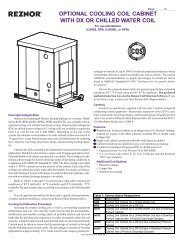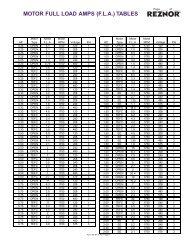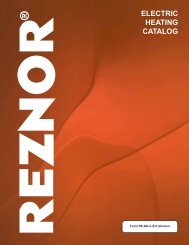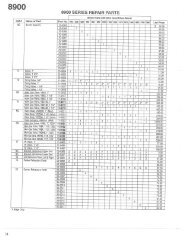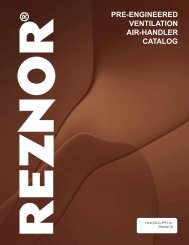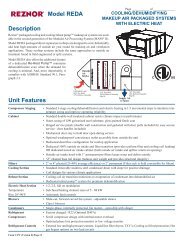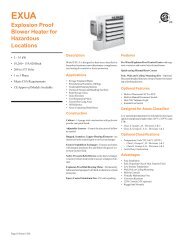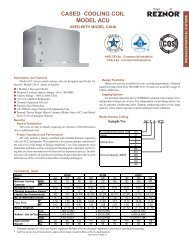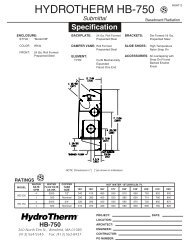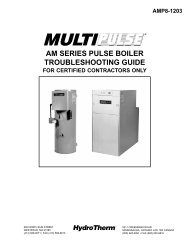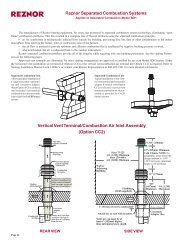MODEL FIII-SERIES CONTROL INSTALLATION ... - Agencespl.com
MODEL FIII-SERIES CONTROL INSTALLATION ... - Agencespl.com
MODEL FIII-SERIES CONTROL INSTALLATION ... - Agencespl.com
Create successful ePaper yourself
Turn your PDF publications into a flip-book with our unique Google optimized e-Paper software.
ohm method (type 4). The relay contacts on the MASTER<br />
will then be connected to the associated 4-20ma<br />
REMOTE ENABLE inputs on the associated boiler(s).<br />
NOTE<br />
The minimum setting of the boiler is calibrated so<br />
that the minimum PWM signal to control the Blower<br />
motor is 20%. The VFD to blower motor operates<br />
with a control signal from 20% - 80% Pulse Width<br />
Modulation. This PWM signal to the VFD can be<br />
measured using a multimeter. It is a 0–10volt square<br />
wave signal at 110 Hertz. A 20% modulation signal<br />
will read 2.0 VDC, and an 80% modulation signal<br />
will read 8.0 VDC on an RMS multimeter.<br />
Circulator Pump Options<br />
The circulator pump options are intended for the boilers<br />
local circulator pump. The circulator pump is supported<br />
by (3) modes.<br />
1. The first mode will allow the circulator<br />
pump to remain on, unless the control’s<br />
outside high air temperature setting has been<br />
met when using OUTDOOR AIR RESET.<br />
2. The second mode will allow the circulator<br />
pump to be turned on whenever there is a<br />
call for heat (any control input). This mode<br />
will stop the circulator pump when the call<br />
for heat is lost and the pump post purge time<br />
has been satisfied.<br />
3. The third mode allows the inlet sensor<br />
(RETURN) to be used with the outlet sensor<br />
(SUPPLY) to keep the pump on until a delta<br />
(difference) temperature is met. The return<br />
temperature sensor is required for this mode,<br />
since the delta temperature (SUPPLY –<br />
RETURN) measured is across the boiler. In<br />
this mode, the post purge time is also used,<br />
and after the delta temp has been met, the<br />
post purge time needs to expire before the<br />
pump is turned off.<br />
If a flow switch is connected to the WTR FLW<br />
interlock, the <strong>FIII</strong> control will wait up to 10 seconds to<br />
prove flow. If flow is interrupted after it has been<br />
established, an error will be displayed and the boiler<br />
will cycle OFF. As long as there is a call for heat,<br />
every 10 minutes the circulator pump will try to reestablish<br />
flow and start the boiler again.<br />
REV 1.1<br />
<strong>FIII</strong> <strong>SERIES</strong> <strong>CONTROL</strong><br />
temperature. In the case of a single boiler system, the<br />
boiler’s outlet (SUPPLY) sensor will only be needed<br />
(Local Control).<br />
Auxiliary Function Options<br />
If less than 3 boilers are used in a stand-alone (no<br />
external control) configuration, the third boiler relay<br />
contact can be used to control a <strong>com</strong>bustion air damper.<br />
A proof time of up to 4 minutes can be set before the<br />
boiler can start or an alarm condition will occur. If the<br />
boiler configuration is for a single boiler, either the<br />
second or third boiler relays can be used for this option.<br />
Sensors<br />
The <strong>FIII</strong> control supports a standard 10K thermistor.<br />
These sensors can be calibrated to the control by<br />
entering the sensor menu and placing a precision 10k<br />
resistor on an input.<br />
Security<br />
A password can be used to lock out control and setup<br />
features. It can be enabled, but is shipped in the<br />
disabled state.<br />
Diagnostics<br />
The <strong>FIII</strong> control can display and identify faults in a<br />
meaningful way. If an interlock trips, it will be<br />
indicated in the main screen display, along with an<br />
audible alarm and a set of relay contacts will close. A<br />
record of this, with a time stamp, will also be entered<br />
into the log as an aide in the diagnosis of the event. The<br />
log can be downloaded and a histogram used to display<br />
the data TBD.<br />
Open and shorted sensors are checked continuously, so<br />
that in the event of a sensor failure, the system shuts<br />
down and the alarm relay is closed.<br />
Communications<br />
The <strong>FIII</strong> control has the ability to <strong>com</strong>municate using the<br />
MODBUS protocol with a building management system.<br />
Most registers and functions are available through<br />
MODBUS access. Access is allowed using the RS485<br />
CONSOLE connecter on the <strong>com</strong>munication board.<br />
PID Control Algorithm Options<br />
The control algorithm can be used with an outdoor reset<br />
ratio, and can regulate water temperature from the loop<br />
(header temperature), or from the boiler’s outlet<br />
Page 9




